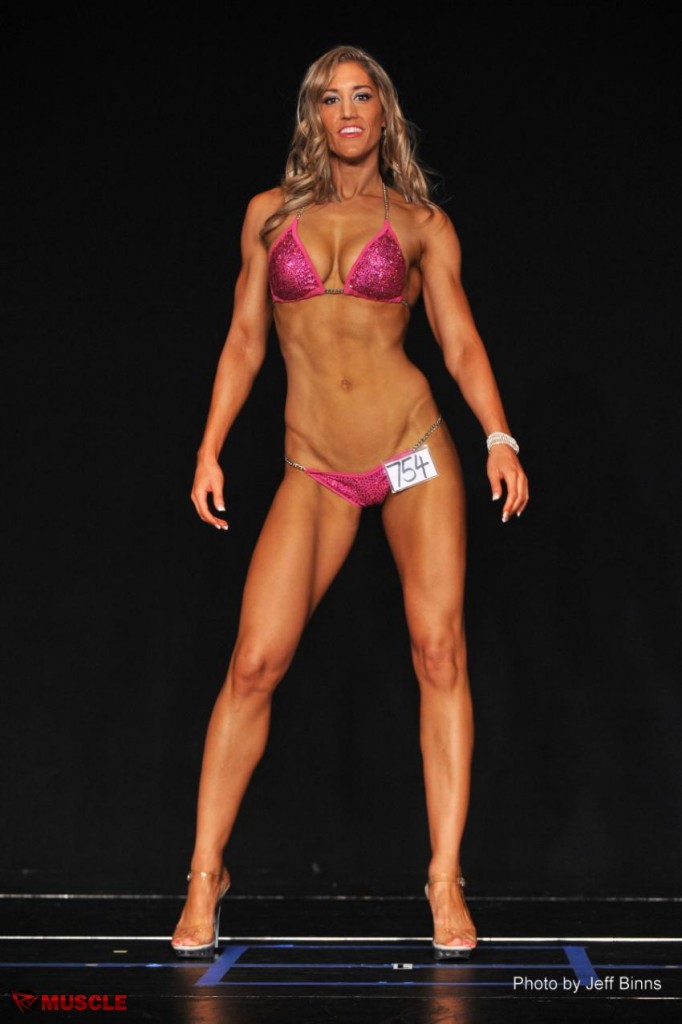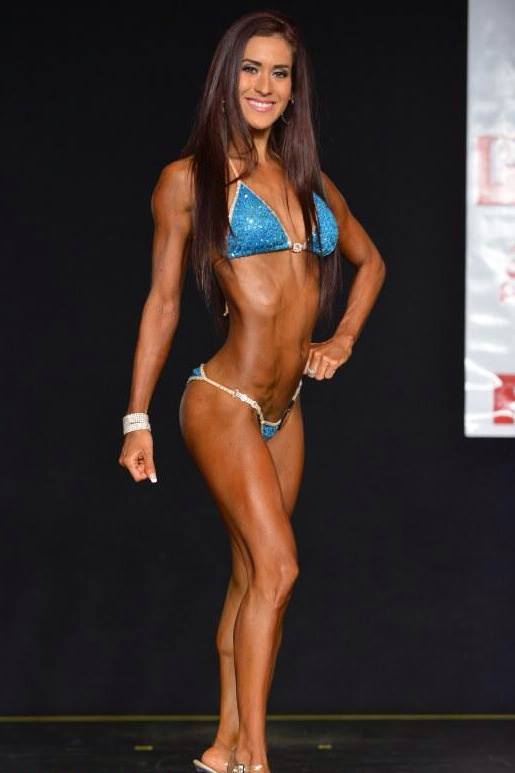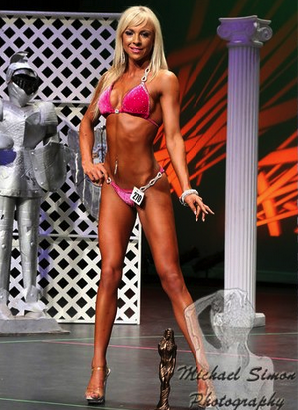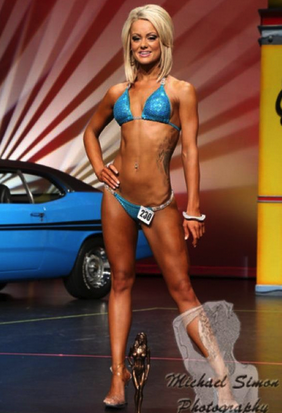Preface: Because this topic is highly controversial in various fitness circles, I decided to back up my writing with anecdotal evidence in the form of photographs. I’m not just some geeky arm chair expert, I’m an actual personal trainer (Instagram page HERE) with 18 years of professional experience. Therefore, throughout this article, you will see pictures of clients I’ve actually trained in person, each of whom performed squat and deadlift variations throughout the course of their preparation.
For the past couple of decades, bodybuilders have been cautioning fellow bodybuilders, advising them to avoid squatting and deadlifting on the premise that they add mass to the midsection and create a blocky appearance. This advice is especially doled out to female competitors, since it is of even greater importance for them to maintain their curvy, feminine appearance.
But is there any truth to this claim? Let’s delve deeper into this matter to see if it holds up under scrutiny. The first problem with the claim that squats and deadlifts make your waist blocky is the subjective nature of what entails “blocky.” From the side view, larger erector spinae and rectus abdominis muscles could cause an individual to appear blockier, but it is unlikely that this is what people making the claim are referring to. It is more likely that these people are referring to the front view, which would be most impacted by the size of an individual’s internal and external oblique muscles.

Squats and deadlifts didn’t give Katie Coles a blocky midsection
The second problem with the claim is the complete lack of longitudinal training studies investigating the effects of squats and deadlifts on abdominal wall hypertrophy or comparing the core muscle growth associated with squats and deadlifts to that achieved via single joint exercises such as supermans, crunches, and side crunches. Since there are no training studies to go by, all we can do is speculate based on acute mechanistic studies.
This leads us right into the third problem with the claim – squat and deadlift naysayers never seem to pinpoint a mechanism as to how squats and deadlifts lead to excessive growth in the midsection. Since they haven’t narrowed down a mechanism, one can only guess as to how they believe this happens. I imagine that they believe that squats and deadlifts create excessive core muscle hypertrophy due to very high activation in the abdominal and oblique musculature.

Squats and deadlifts didn’t give Erin McComb a blocky midsection
It is indeed true that squats and deadlifts highly activate the erector spinae muscles. Interestingly, squats activate the lumbar erectors to a greater degree than deadlifts, whereas deadlifts activate the thoracic erectors to a greater degree than squats.[i] However, several studies to date show that abdominal and oblique activity during the squat and deadlift are not substantially high, and that basic ab/core isolation exercises outperform squats and deadlifts in abdominal and oblique activity.2-5
Through EMG experimentation in my own lab, I’ve found that many common exercises match or exceed squats and deadlifts in rectus abdominis and oblique activation, including chin ups, military press, hip thrusts, reverse hypers, push ups, pullovers, tricep extensions, and curls. In addition, I’ve found that most targeted abdominal/core exercises exceed (sometimes far exceed) squats and deadlifts in abdominal and oblique activation, including RKC planks, side planks, bodysaws, hollow body holds, ab wheel rollouts, weighted crunches, straight leg sit ups, hanging leg raises, dragon flags, lying leg raises, suitcase carries, side bends, cable chops, and landmines.

Squats and deadlifts didn’t give Sammie Cohn a blocky midsection
I propose a multifaceted alternative reason for why bodybuilders believe that squats and deadlifts create a blocky appearance. First, due to increased knowledge pertaining to training, nutrition, and supplementation, bodybuilders have gotten exceedingly larger over the past couple of decades. Bigger bodies require larger organs in order to carry out their necessary processes. Therefore, bodybuilders’ entire midsections are growing larger, but this doesn’t apply to women that strength train, since women generally avoid intentionally growing their bodies 25-50% larger.
Second, many bodybuilders regularly take a variety of performance enhancing substances including human growth hormone, which is believed to lead to increased organ growth and a distended appearance in the belly region in bodybuilding communities. Obviously, this factor also doesn’t warrant consideration from women because they generally avoid taking human growth hormone in concordance with other anabolic drugs. Heavily drugged bodybuilders experience a wide range of side effects that natural lifters don’t need to concern themselves with, including acne, expedited hair-loss, and distended bellies.

It’s gotta be the squats and deads…it can’t be the drugs, right?
And third, bracing the core during squats and deadlifts requires considerable intraabdominal pressure (IAP) to properly stabilize the spine. Though the diaphragm muscle is largely responsible for this increase in IAP, humans are by nature quite poor at relating sensation to proper physiological actions. Therefore, bodybuilders confuse high diaphragm activity and subsequent outward pressure in the midsection with high levels of abdominal and oblique activity.
Old school bodybuilders believed that “drawing in” the abdominal wall through vacuum poses helped keep the midsection tight through transversus abdominus (TVA) strengthening. One could plausibly make the argument that frequent bracing of the core leads to growth in the midsection due to pushing outward on the abdominal wall via IAP production. Even though abdominal and oblique activation is low during squats and deadlifts, the midsection could grow due to increased connective tissue extensibility due to persistent stretching. However, bracing the core doesn’t involve maximal expansion and stretching of the abdominal wall, so this is doubtful.

Squats and deadlifts didn’t give Chelsey Mcallister a blocky midsection
Having trained numerous bikini competitors, I can tell you that midsection appearance is largely related to genetics. Although my clients train in the same fashion and perform the same exercises, some of them step on stage with narrow, tapered waists while others aren’t quite as lucky. However, not a single bikini competitor ever showed up on stage appearing blocky, despite including squat and deadlift variations in their prep. If a woman is concerned with obtaining a blocky appearance, I would recommend ditching targeted abdominal and oblique exercises rather than avoiding squats and deadlifts.
Conclusion
Squats and deadlifts highly activate the erector spinae to prevent flexion of the spinal column. The abdominals and obliques cocontract along with the erectors in order to enhance core stability, but the levels of activation reached in these muscles is on par with many common strength training exercises. Furthermore, most popular isolated core exercises, both static and dynamic, activate the abdominals and obliques to a much greater degree than squats and deadlifts. Therefore, on the basis of abdominal and oblique activation, if lifters should avoid squats and deadlifts to prevent becoming blocky, then they should also avoid most other popular exercises, which is ludicrous.
Women do not need to fear that squats and deadlifts will cause them to develop a blocky midsection. This phobia has been generated by well-intentioned but misguided bodybuilders who use squats and deadlifts as a scapegoat to explain the excessive midsection growth that they experienced when they packed on dozens of pounds of muscle mass in concert with human growth hormone, insulin, and anabolic steroids. What these bodybuilders experience doesn’t apply to the masses. This conclusion is anecdotally supported by the fact that most top-level bikini competitors regularly include squat and deadlift variations in their training.
References
- Hamlyn et al. 2007 | Trunk muscle activation during dynamic weight-training exercises and isometric instability activities
- Bressel et al. 2009 | Effect of instruction, surface stability, and load intensity on trunk muscle activity
- Aspe & Swinton 2014 | Electromyographic and kinetic comparison of the back squat and overhead squat
- Willardson et al. 2009 | Effect of surface stability on core muscle activity for dynamic resistance exercises
- Escamilla et al. 2002 | An electromyographic analysis of sumo and conventional style deadlifts






Great post! Although I never ditched squats and deadlifts, I was paranoid about the effects of my waist once I went heavy enough.
In general though, would you recommend core exercises or females, or would you say it’s purely personal preference or for psychological comfort? Could focusing on core exercises cause blockiness with enough volume?
Of course, with enough volume. I don’t have my physique clients do additional ab work (females). Actually, some of them do some after their workouts and I don’t say anything, but it’s only a couple of sets twice per week. With men, I like them to perform additional core work.
Hi Bret! I’m following strong curve program and currently im on week 4-9. Love the program so much!!! I’m listening your pot cast over and over until I could understand what you said. Because I’m a Japanese women. I’m very interested in this topic. Iam always wander, why crossfit-athletes women has a wide torso? Why they doesn’t looks like a bikini competitors? They both do strength training. For this reason, many ppl consider that heavy compound movements make women looks chunkier.
What do you think about this? Before I read your books I had been avoided heavy weight lifting training and just did plyo circuit trainings. Please give me your thoughts. Thank you very much.
Good question Chihara, I think Crossfitter women get thick cores from such high frequency/high volume/high intensity training. Tons of overhead movements, chin ups, sit ups, etc. Some of the top competitors are likely using performance enhancing drugs.
I am a natty and heavy core movements will thicken the waist, especially heavy squats. It’s from all the core bracing, fill the stomach with air, tighten, push on belt (for those who use a belt).
I look back at photo’s of myself prior to to including heavy powerlifting movements,
and my waist has thickened from front and side. Certainly not to the extent of those drug
infested bodybuilders in the picture you posted – but in the area of inch or so. It also seems to
happen in the first year or two – get to a certain point and stay there.
Great article, Bret!
What could also be an explanation for the confused adherents to that theory: As it is often in sports, the alleged causal relationship “high dl/squat levels –> thick waist” probably is simply a correlation by selection effects: Strong deadlifters and squatters, especially in the higher weight classes (which is a synonym for strong dls and squats for the layman anyway), certainly have large frames and joints. But not predominantly (or not at all) because of their training, but they only got so far because their genetical determined anatomy enabled them to endure to lift huge weights. And maybe also because of a confounded variable: The same genetics that determine muscle growth also determine joint circumference. As we all know, joint circumference is correlated with muscle hypertrophy potential. In short: genetics —> a) frame and b) muscle hypertrophy (pls dont swamp me with anecdotal counter examples, as always in science were talking about averages here and those averages are well documented.) 🙂
Another great article – Thanks Bret! I can’t tell you how many times a couple of my male friends have told me that I should be careful how much I deadlift because I’ll “get thick.” I’m not trying to be a bikini competitor or anything, but I have now been deadlifting 2-3x per week for the past year, with the pleasant side effects of losing nearly 40 lbs, gaining a lot of muscle, trimming 6 inches off my waist, and increasing my hip-to-waist ratio. Going for a 300lb PR on deadlift — twice bodyweight! Looking forward to sending this article their way… ha-HA!
I do have a question though– It seems like many of the fitness people I follow on Instagram kind of ‘demean’ doing specific abdominal work/exercises (kind of like a “why do crunches when you can dead-lift lol” mentality). The belief now seems to be that engaging in compound lifts such as deadlifts and squats will work your abdominals as well as (if not better) than targeted ab exercises, and that you don’t need to do specific ab exercises to develop a coveted six-pack. This article, however, seems (to me) to show evidence that ab exercises do indeed engage abdominal muscles moreso than deads or squats. So are these Instagrammers/Fitness personalities wrong? Partly right? Should we be throwing away our ab exercises and just doing compound lifts? Or is it a matter of– we don’t need to be doing crunches and ab exercises like crazy, thinking that they are the ONLY thing that work our abs… adding them into a workout routine in moderation is appropriate? Sorry to get a bit off topic there, but I’ve been wondering about this for awhile and reading your article made me think of it again 🙂
Katrina, yes, they’re wrong. Dead wrong. This is another stupid misconception out there. But it just depends on the look you’re going for. I don’t have my bikini competitors do abs. They look incredible when they diet down…no need for additional hypertrophy. However, if I train athletes, I definitely have them performing core stability exercises.
Wait, really? I must have missed this gym floor chit-chat. I see a guy or gal with what appears to be bloat, my first assumption is pharmacological override, not squats. That’s funny stuff, Bret. Thanks for breaking this one down for us. The data certainly seals your point.
I guess I’m one of the few people out there that actually wants to strive to get a blockier mid-section instead of the v taper (I know, absolute heresy). Specifically, I’ve been drawn to the ancient Greek ideal of aesthetics, where one of the most salient feature are developed obliques:
http://www.davidgentle.com/sandow/sandow/ss/s-s-03.jpg
http://www.mlahanas.de/Greeks/LX/HerculesFarnese01.jpg
http://www.vroma.org/images/bonvallet_images/bonvall30.jpg
For someone who only wants a slim waist and something resembling a six pack, heavy compounds are more than enough, since getting that ideal waist will mostly come down to bodyfat levels. If you want more hypertrophy (or strength) in the area, you should add isolated dynamic or static exercises.
Hey Bret,
First let me say, I LOVE what you do! And can’t wait to get a Hip Thruster for our home gym in the coming months.
Second, question for you: what about the waist thickness from the side?
I notice in a lot of your testimonial pictures the women not only increase glute size but the entire waist/torso slims out and changes shape. How does this happen/What are your recommendations for this? My core is thick right now and my quads are also SUPER dominate and developed and always want to take over (maybe my years as a martial artist and ballet dancer, although I’ve lost my dancer bubble butt which I’m working to get back). I read your article on growing glutes without the legs, so I’m working on that now. My training is mostly kettlebells (I do have barbells and bands, just no hip thruster yet) and just started incorporating some pilates/dance as I’m getting married in September and we are doing some serious lifts in our wedding dance. Would love to hear your thoughts!
All the best,
Nicole Du Cane
COO, Dragon Door
Hi Nicole, it just happens as a result of losing fat without hypertrophying the midsection, so the overall results is a slimmer waist. If you once had a bubble butt I think it’s easier to gain back than it is for people to build up from the ground up (hopefully that makes sense). My advice is 1) build up your hip thrust strength as much as possible in the next few months, and 2) employ 10-min band glute workouts around 3-5 times/week where you alternate between things like banded hip thrusts, banded goblet squats, lateral band walks, etc. Best of luck!!! And congrats on the engagement 🙂 BC
What are your thoughts on women wearing a weight training belt when lifting? I heard from a former bikini competitor that she wears one to prevent overdevelopment of oblique muscles when weight training. I just started lifting in April and I’m trying to decided if I should get one – I don’t want to thicken my waist. Any info is appreciated, thanks!
I have been doing dead lifts and squats for more than 20 years, but they have not made my waist blocky.
Bret you are correct, athletes that use performance enhancing drugs do grow thicker midsections, I know this from competing in Figure and Physique and using during the training. When I stopped my waist became smaller.
what’s the best exercise to target the core? I feel this is a weakness in me and holding back dl’s and squats.
when i Military press heavy….my lower back gets it and is the muscle that prevents me going heavier.
thx
Bret, I have a question for you based on my own anecdote. I started training about two years ago, and in the first year I dropped a ton of body fat and got down to a 31.5″ waist at about 10%BF. Now, a year later (March 2015-July 2016) I’m just about the same body fat percentage but my waist sits at about the 33″ mark and it doesn’t seem like there’s anything else to lose in that area in terms of body fat.
Over those ~15 months, I’ve focused almost all my efforts on compound movements done at a relatively high frequency (back squats and deadlifts at 80%+ of 1RM about 3 times a week). In terms of my situation, is it not possible that I’ve hypertrophied those core muscles through compound work? I just don’t see what else could cause it (I rarely do any ab-specific work, though I know I should do more.)
Thanks for the article!
Hi Bret,
I would REALLY love to hear your opinion. I’m actually a victim of weighted ab work overload- I used to have a 24 inch waist- and now it’s 27 inches! It’s especially alarming because my hip ratio did not increase at same rate. I wish I had read this article sooner– as I saw my waist growing I thought it was just my metabolism slowing down as I hit my mid 20s- but in retrospect it was definitely all of those ab exercises I did over the course of a year.
I have an important question for you and really hope you can respond! It’s been about 5 months since I have stopped all core workouts- and so far I haven’t noticed my waist shrinking.
My question is: will my abs/lats/obliques ever shrink back to original size?!
I worry that even with hip thrusts and squats I am not allowing the ab hyper trophy to revert back to its original state.
Please help!
Thank you,
Erika
Hi bret! Just got a quick question if you have time. I read your article about heavy ab training increased your waist size, i just wondered if your waist size got back to pre training size when you stopped working them directly or if they maintaind their size because of the indirect stimuli from heavy compound lifts? Thank you for your time.
Awesome artilc Bret!
I will be linking this post on my website about why people should train legs. This will be to dispell the fear many have that it will make them appear bulky.
I’ve read before that a blocky waist can be caused by doing weighted oblique work that involves twisting or side-to-side movements, so I’ve avoided those types of exercises in my training. Would you agree with that assessment? N=1, but it seems to have worked for me.